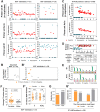A Novel Saliva RT-LAMP Workflow for Rapid Identification of COVID-19 Cases and Restraining Viral Spread
- PMID: 34441334
- PMCID: PMC8391450
- DOI: 10.3390/diagnostics11081400
A Novel Saliva RT-LAMP Workflow for Rapid Identification of COVID-19 Cases and Restraining Viral Spread
Abstract
Rapid diagnostics is pivotal to curb SARS-CoV-2 transmission, and saliva has emerged as a practical alternative to naso/oropharyngeal (NOP) specimens. We aimed to develop a direct RT-LAMP (reverse transcription loop-mediated isothermal amplification) workflow for viral detection in saliva, and to provide more information regarding its potential in curbing COVID-19 transmission. Clinical and contrived specimens were used to optimize formulations and sample processing protocols. Salivary viral load was determined in symptomatic patients to evaluate the clinical performance of the test and to characterize saliva based on age, gender and time from onset of symptoms. Our workflow achieved an overall sensitivity of 77.2% (n = 90), with 93.2% sensitivity, 97% specificity, and 0.895 Kappa for specimens containing >102 copies/μL (n = 77). Further analyses in saliva showed that viral load peaks in the first days of symptoms and decreases afterwards, and that viral load is ~10 times lower in females compared to males, and declines following symptom onset. NOP RT-PCR data did not yield relevant associations. This work suggests that saliva reflects the transmission dynamics better than NOP specimens, and reveals gender differences that may reflect higher transmission by males. This saliva RT-LAMP workflow can be applied to track viral spread and, to maximize detection, testing should be performed immediately after symptoms are presented, especially in females.
Keywords: 2019 novel coronavirus; LAMP (loop-mediated isothermal amplification) assay; saliva; viral diagnostics.
Conflict of interest statement
The authors declare no conflict of interest.
Figures







References
-
- Leal F.E., Mendes-Correa M.C., Buss L.F., Costa S.F., Bizario J.C.S., de Souza S.R.P., Thomaz O., Tozetto-Mendoza T.R., Villas-Boas L.S., de Oliveira-da Silva L.C., et al. Clinical features and natural history of the first 2073 suspected COVID-19 cases in the Corona São Caetano primary care programme: A prospective cohort study. BMJ Open. 2021;11:e042745. - PMC - PubMed
Grants and funding
LinkOut - more resources
Full Text Sources
Miscellaneous

